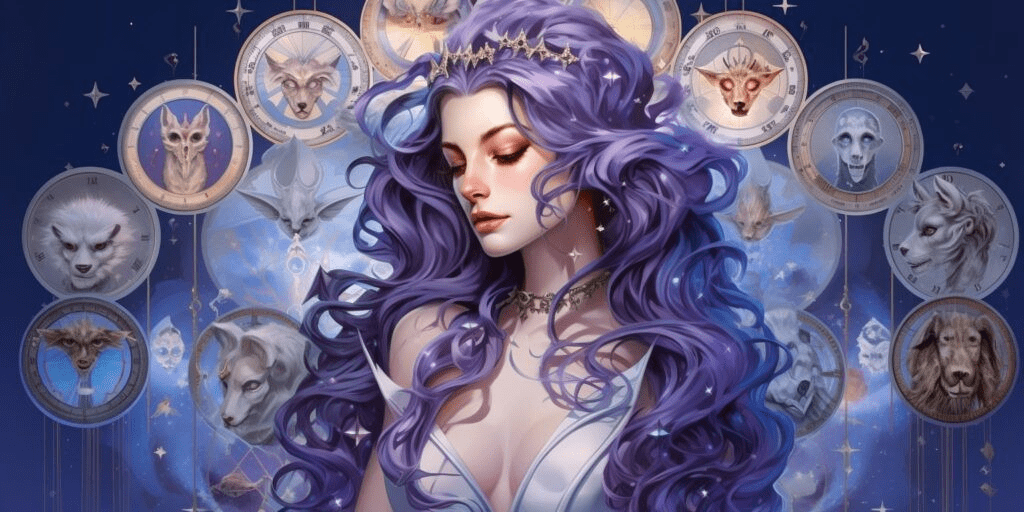Origins and Historical Background
The Chinese zodiac dates back over 2,000 years to the Han Dynasty and is deeply rooted in Chinese cosmology, the lunar calendar, and Taoist philosophy. Its origin story involves a mythical race between animals, each earning a place in the 12-year cycle.
In contrast, the Western zodiac stems from Babylonian astrology and was later shaped by Greek and Roman mythology. It’s based on the path of the sun through twelve constellations over a solar year.
Number and Types of Signs
Both systems feature 12 signs, but the nature of these signs is fundamentally different:
-
Chinese Zodiac: 12 animals — Rat, Ox, Tiger, Rabbit, Dragon, Snake, Horse, Goat, Monkey, Rooster, Dog, Pig.
-
Western Zodiac: 12 constellations — Aries, Taurus, Gemini, Cancer, Leo, Virgo, Libra, Scorpio, Sagittarius, Capricorn, Aquarius, Pisces.
Each Chinese sign is assigned to a year, while Western signs correspond to months.
Time Basis and Zodiac Cycle
-
Chinese Zodiac: Operates on a 12-year lunar cycle. Your sign is determined by your birth year.
-
Western Zodiac: Follows the solar calendar. Your sign is based on your birth date.
This fundamental time difference leads to very different astrological interpretations.
Symbolism and Cultural Meaning
Chinese zodiac animals are deeply symbolic in Eastern culture. For example, the Dragon symbolizes power and prosperity, and the Pig represents wealth and generosity.
Western signs have symbolic links to Greek mythology. For instance, Leo is linked to the Nemean lion defeated by Hercules, while Sagittarius is a centaur with a bow representing exploration.
The Role of Elements in Each System
-
Chinese Astrology includes five elements: Wood, Fire, Earth, Metal, and Water. These rotate every two years, creating a 60-year cycle when combined with the 12 animals.
-
Western Astrology uses four elements: Fire, Earth, Air, and Water, repeated three times among the 12 signs.
These elements influence your behavior, strengths, and interactions.
Personality Interpretation
-
Chinese Zodiac: Traits are based on your animal sign and element. For example, a Metal Rat is strategic and tough-minded.
-
Western Zodiac: Traits are linked to planetary placements, including your sun, moon, and rising signs.
Western astrology tends to be more nuanced, while Chinese astrology offers broad archetypes.
Charting Methods
-
Chinese Astrology: Uses lunar calendars and stems-and-branches theory. It emphasizes BaZi (Four Pillars of Destiny) which factors in year, month, day, and hour of birth.
-
Western Astrology: Relies on natal birth charts to map celestial positions at the time of birth.
Both systems require precise birth information but use different cosmological frameworks.
Compatibility and Relationship Matching
In Chinese astrology, compatibility is assessed by animal trines and conflicting pairs. For instance, Dragon and Rat are highly compatible, while Tiger and Monkey clash.
In Western astrology, it’s about elemental harmony and planetary positions. Fire signs (e.g., Aries and Leo) tend to pair well with Air signs (e.g., Gemini and Libra).
Horoscope Predictions
-
Chinese horoscopes focus on annual predictions, particularly during the Lunar New Year.
-
Western horoscopes offer daily, weekly, and monthly insights, commonly found in newspapers and apps.
Each system provides a unique rhythm for forecasting life events.
Impact on Festivals and Rituals
-
Chinese zodiac animals dictate the theme of each lunar year (e.g., Year of the Rabbit). It influences cultural celebrations, gifts, and rituals during Chinese New Year.
-
Western zodiac signs are often celebrated through birthstones, horoscope readings, and birthday-related themes.
Global Popularity and Modern Relevance
-
Chinese Zodiac: Widely followed in China, Taiwan, Singapore, and by the global Chinese diaspora.
-
Western Zodiac: Dominates in Europe, the Americas, and globally through popular media.
Many people now use both for a fuller understanding of themselves.
Can They Be Combined?
Yes! Many astrologers blend both systems to provide a more holistic astrological profile. For instance:
-
A Leo born in the Year of the Snake might be confident and magnetic, but also introspective and strategic.
-
A Pisces born in the Year of the Horse could combine sensitivity with a love for freedom and adventure.
This combination enhances self-awareness and decision-making.
FAQs About Chinese vs Western Zodiac
1. Can I have both a Chinese and Western zodiac sign?
Yes, everyone has one of each, based on birth year and birth date.
2. Which system is more accurate?
Neither is universally “more accurate”—they offer different lenses for self-reflection.
3. Why are some Chinese zodiac years seen as luckier?
Some animals, like the Dragon, are culturally tied to success and fortune.
4. Do both systems use elements?
Yes, but Chinese astrology has five rotating elements; Western uses four repeating ones.
5. Is the Chinese zodiac always based on the lunar calendar?
Yes, Chinese zodiac years begin on Chinese New Year, not January 1st.
6. How do I find my full Chinese zodiac profile?
Look up your BaZi chart, which considers the hour, day, month, and year of birth.
Conclusion
When comparing the Chinese vs Western zodiac, you’ll find distinct systems with deep cultural roots, unique philosophies, and insightful frameworks. Whether you’re aligning with your birth animal or decoding your natal chart, both zodiacs offer rich paths to self-understanding and growth.
Consider using both as complementary tools—you might uncover layers of yourself you never expected.




